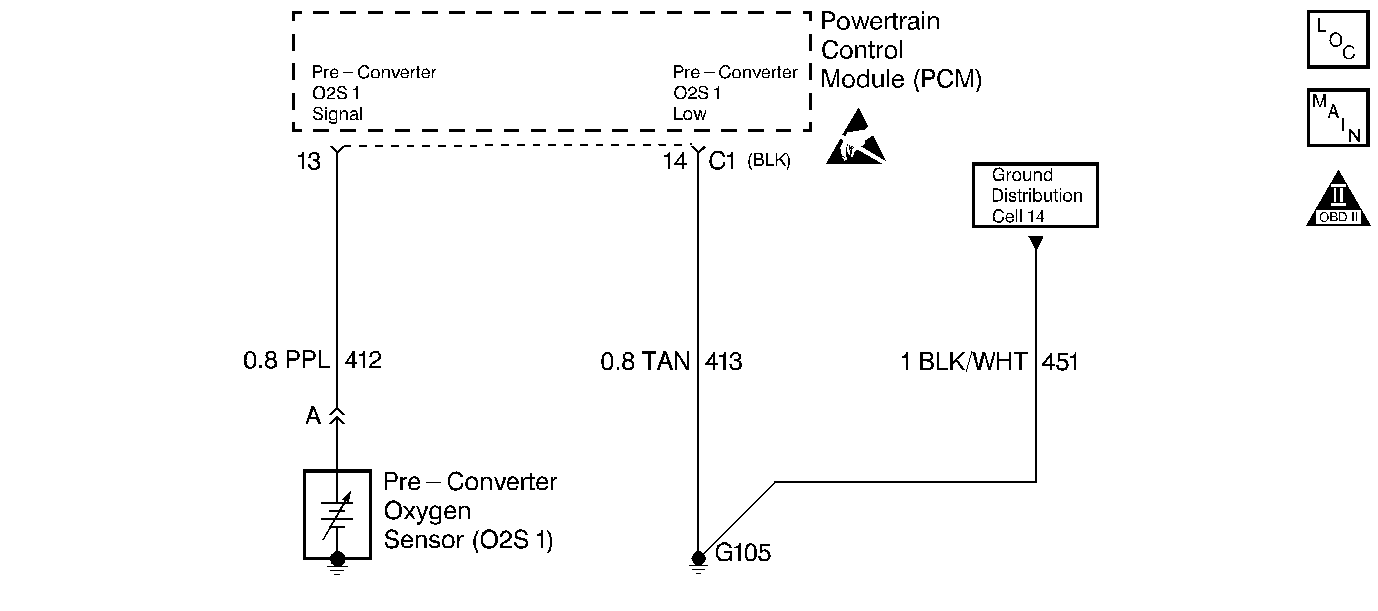
Circuit Description
The Powertrain Control Module (PCM) supplies a reference voltage of about 0.45 volt to the Oxygen Sensor (O2S). The O2S 1 voltage varies within a range of about 1.0 volt when the exhaust is rich, down to about 0.10 volt when the exhaust is lean.
Conditions For Setting The DTC
| • | The O2S 1 voltage is between 407 mV and 509 mV (auto) |
| • | The O2S 1 voltage is between 399 mV and 499 mV (manual) |
| • | The engine run time is greater than 30 seconds |
| • | The TP angle is between 10 % and 55 % |
| • | The Engine Coolant Temperature (ECT) is greater than 70° C (158° F) |
| • | The above conditions are present for at least 150 seconds |
| • | When one or more of the following DTCs are not set, P0107, P0108, P0112, P0113, P0117, P0118, P0121, P0122, P0123, P0300, P0301, P0302, P0303, P0304, P0562, P0563, P1441. |
Action Taken When the DTC Sets
| • | The malfunction indicator lamp (MIL) will illuminate. |
| • | The PCM will record the operating conditions at the time that the diagnostic fails. The Freeze Frame and Failure Records buffers will store this information. |
| • | A history DTC stores. |
Conditions for Clearing the MIL/DTC
| • | The malfunction indicator lamp (MIL) will turn OFF after 3 consecutive ignition cycles in which the diagnostic runs without a fault. |
| • | A history DTC will clear after 40 consecutive warm up cycles without a fault. |
| • | Use a scan tool to clear the DTCs. |
Diagnostic Aids
| • | When the oxygen sensor pigtail wiring, connector or terminal are damaged, the entire oxygen sensor assembly must be replaced. Do not attempt to repair the wiring, the connector or the terminals. In order for the sensor to function properly, the O2S must have a clean air reference. This clean air reference is obtained by way of the oxygen sensor wires. Any attempt to repair the wires, connectors or terminals could result in the obstruction of the air reference and degrade the oxygen performance of the sensor. |
| • | The normal scan tool voltage varies between 150 mV to 850 mV (0.15 volt to 0.85 volt) when in a Closed Loop. The DTC P0134 sets in approximately 88 seconds when the voltage remains between 0.407 volt and 0.509 volt. The system will go into an Open Loop in about 30 seconds. |
Test Description
The numbers below refer to the step numbers on the diagnostic table.
-
The Powertrain OBD System Check prompts the technician to complete some basic checks and store the Freeze Frame Data and the Failure records on the scan tool if applicable. This creates an electronic copy of the data taken when the fault occurred. This information on the scan tool can be referred to later.
-
During engine warm-up, the O2S 1 should warm-up and the O2S voltage output should vary between 150 mV and 850 mV. When the O2S 1 voltage varies, the vehicle will go into a Closed Loop. This step determines if the O2S 1 is operating properly.
-
This will determine if the O2S 1, the wiring or PCM is the cause of the DTC P0134.
-
Use only a high impedance digital volt ohmmeter for this test. This test checks the continuity of the O2S 1 signal and the O2S 1 ground circuit. When the O2S 1 ground circuit is open, the PCM voltage on the O2S 1 signal circuit will be over 0.6 volt (600 mV).
-
Before replacing the PCM, check terminals for improper mating, broken locks, or physical damage to the wiring harness. Reprogram the replacement PCM. Refer to the latest Techline information for programming procedures.
Step | Action | Value(s) | Yes | No |
|---|---|---|---|---|
Was the Powertrain On-Board Diagnostic (OBD) System Check performed? | -- | |||
Does the scan tool indicate a Closed Loop? | 80° C (176° F) 1200 RPM | |||
3 |
Does the scan tool indicate a Closed Loop? | -- | ||
Is the O2S 1 voltage below the specified value? | 200 mV (0.2 V) | |||
5 |
Was a repair made? | -- | ||
Does the O2S 1 voltage measure above the specified value? | 600 mV (0.6 V) | |||
7 | Does the O2S 1 voltage measure below the specified value? | 300 mV (0.3 V) | ||
Replace the PCM. Refer to Powertrain Control Module Replacement/Programming . Is the action complete? | -- | -- | ||
9 | Replace the O2S 1. Refer to Oxygen Sensor Replacement . Is the action complete? | -- | -- | |
10 |
Was a repair made? | -- | ||
11 |
Was a repair made? | -- | ||
12 |
Does the scan tool indicate that this diagnostic ran and passed? | 90°-95° C | ||
13 | Check if any additional DTCs are set. Are any DTCs displayed that have not been diagnosed? | -- | Go to the Applicable DTC Table | System OK |
